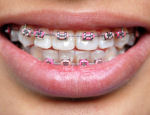
Dental Braces • How do Braces Work?
Orthodontic treatments are usually based on the use of dental braces for aligning teeth. Dental braces (also known as orthodontic braces) are fixed appliances used by orthodontists to correct orthodontic problems such as underbite, overbite, crossbite and openbite, or crooked, crowded teeth. Other types of orthodontic appliances may also be used in the course of treatment (headgear, retainers etc) but dental braces remain the main tool of orthodontists in correcting malocclusion problems.
What are Dental Braces?
Braces consist of a combination of brackets that are bonded to the teeth, and arch wires that are threaded through the brackets, along with spacers, springs and bands.
Brackets are the small squares that are attached directly to each tooth with a special dental bonding agent. Brackets act like handles that help control movement of the teeth. Arch wires attach to the brackets and act as tracks to guide the movement of each tooth to its proper position.
The action of the forces applied to brackets by the arch wires enables the orthodontist to have three-dimensional control over the movement of the teeth. In many cases, additional orthodontic appliances are needed in order to achieve the expected results, such as elastics (rubber bands) hooked to teeth, headgear, functional appliances and palatal expanders.
How do Dental Braces Work?
Dental braces work by applying constant pressure on the teeth, in a desired direction, over a period of time. The force applied can not be too high, because it will damage the tooth and periodontal tissues. You can not expect to align your teeth in a few days. It is the gentle constant pressure for an extended period of time that moves teeth in their proper position.
Dental braces work by pushing the tooth in a specified direction and the stress created within the periodontal ligament triggers a biological process which leads to bone remodeling. During this process the bone in the compressed side of the tooth is gradually resorbed, while on the other side new bone is created within the periodontal ligament to fill the gap created by the movement of the tooth (deposition).
A tooth will usually move about a millimeter per month during orthodontic treatment. depending on individual patient’s response to treatment. The pressure has to be adjusted by the orthodontist every few weeks during the orthodontic treatment, which can last from one to three years or longer depending on the severity of the patient's case.
There are several types of dental braces provided by orthodontists, from the traditional metal braces to ceramic "tooth-colored" braces, clear plastic braces and the more modern Invisalign braces. All types of dental braces work in a similar way, except Invisalign that are actually retainers and not braces. You can expect to feel a little uncomfortable when you wear braces for the first time and for one-two days after each time they are readjusted and ‘tightened’ by the orthodontist. The sharp edges of the archwires can be covered with dental wax for braces to prevent sores on the inner cheeks and lips.
Once the orthodontic braces are removed, a dental retainer may be recommended by the orthodontist to hold teeth in their proper position and not allow them to move back to their prior position.
![]() The cost of orthodontic treatment can be significant and many patients may not afford it if they are not covered by their dental insurance.
Learn how to choose a dental insurance plan that will provide the best dental treatment to you and your family.
The cost of orthodontic treatment can be significant and many patients may not afford it if they are not covered by their dental insurance.
Learn how to choose a dental insurance plan that will provide the best dental treatment to you and your family.

